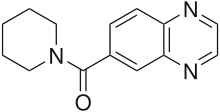AMPA receptor positive allosteric modulator
AMPA receptor positive allosteric modulators are positive allosteric modulators (PAMs) of the AMPA receptor (AMPR), a type of ionotropic glutamate receptor which mediates most fast synaptic neurotransmission in the central nervous system.[1]


Medical applications
AMPAR PAMs have cognition- and memory-enhancing and antidepressant-like effects in preclinical models, and have potential medical applications in the treatment of cognitive impairment (e.g., cognitive symptoms in schizophrenia, mild cognitive impairment), dementia (e.g., Alzheimer's disease), depression, and for other indications.[1][2] They can broadly be divided into low-impact and high-impact potentiators, with high-impact potentiators able to produce comparatively more robust increases in AMPAR activation.[3] However, high-impact AMPAR PAMs can cause motor coordination disruptions, convulsions, and neurotoxicity at sufficiently high doses, similarly to orthosteric AMPAR activators (i.e., active/glutamate site agonists).[2]
The AMPAR is one of the most highly expressed receptors in the brain, and is responsible for the majority of fast excitatory amino acid neurotransmission in the central nervous system (CNS).[4] Considering the broad impact of the AMPARs in the CNS, selectively targeting AMPARs involved in disease is difficult, and it is thought that global enhancement of AMPARs may be associated with an intolerable level of toxicity.[4][1] For this reason, doubt has been cast on the feasibility of AMPAR activators for use in medicine.[1] However, low doses of AMPAR activators may nonetheless be useful, and AMPAR PAMs, which, unlike agonists, show selectivity for AMPAR subpopulations of different subunit compositions, may hold greater potential for medical applications.[4][1]
Pharmacology
AMPAR PAMs bind to one or more allosteric sites on the AMPAR complex and potentiate the receptor.[4] Unlike orthosteric (active/glutamate) site AMPAR activators, otherwise known as AMPAR agonists, AMPAR PAMs only potentiate AMPAR signaling in the presence of glutamate and hence do not activate the receptor directly/themselves.[4] Moreover, whereas AMPAR agonists activate all AMPARs, AMPAR PAMs can show selectivity for specific subpopulations of AMPARs.[4] This is because the AMPAR is composed of different combinations of various subunits, and the allosteric sites differ depending on the different subunit combinations.[4]
AMPAR PAMs can be broadly grouped into two types based on their binding site and impact on AMPAR activation: low-impact (type I) and high-impact (type II).[5] Low-impact AMPAR PAMs have the following criteria:[5]
- Have little or no effect on the half-width of the field excitatory postsynaptic potential (fEPSP); and
- Do not substantially bind to the cyclothiazide site on the AMPAR complex; and
- Do not induce the expression of brain-derived neurotrophic factor (BDNF)
While high-impact AMPAR PAMs have the following criteria:[5]
- Substantially alter/increase the half-width of the fEPSP; and/or
- Substantially bind to the cyclothiazide site on the AMPAR complex; and
- Induce the expression of BDNF
Low-impact AMPAR PAMs decrease AMPAR deactivation (channel closing) alone to augment synaptic currents while high-impact AMPAR PAMs decrease both deactivation and desensitization together to enhance and prolong synaptic currents.[3] Low-impact AMPAR PAMs have only slight effects on AMPAR currents, whereas high-impact AMPAR PAMs have effects more similar to those of AMPAR agonists and can produce strong enhancement.[6][7] Similarly to AMPAR agonists, high-impact AMPAR PAMs can cause convulsions and neurotoxicity in sufficiently high doses.[2] Conversely, low-impact AMPAR PAMs have few adverse effects.[6]
Classes and list of drugs
By chemical structure
There are several major chemical classes of AMPAR PAMs:[8][4]
- Benzamide and related compounds (also known as ampakines or CX compounds; mostly benzoylpyrrolidines) – 1-BCP (BA-14), CX-516 (Ampalex, BDP-12, BA-74, ORG-24292, SPD-420), CX-546, CX-554 (BDP-20), CX-614, farampator (CX-691, ORG-24481, SCH-900460), CX-717, CX-929, CX-1501, tulrampator (S-47445, CX-1632), CX-1739, CX-1796, CX-1837, CX-1942, CX-2007, CX-2076, ORG-26576, S-70340
- Benzothiadiazides – BIIR-777, cyclothiazide, diazoxide, hydrochlorothiazide (HCTZ), IDRA-21, S-18986
- Biarylpropylsulfonamides and related compounds – LY-392098, LY-404187, LY-450108, mibampator (LY-451395), LY-4516146, LY-503430, PEPA, PF-04778574, PF-04958242, CMPDA, CMPDB, (R,R)-PIMSD
- Racetam and related compounds (very weak) – aniracetam, piracetam, various others
- Others: PF-04701475, PF-04958242, GVS-111[9]
These classes have divergent properties, including allosteric site specificity, potency, impact (i.e., low versus high), and selectivity for AMPAR populations composed of different subunits.[8][4] All of the biarylpropylsulfonamides are high-impact AMPAR PAMs, whereas the majority of the ampakines are low-impact AMPAR potentiators.[10] The biarylpropylsulfonamides are highly potent, on the order of 1,000-fold more potent than the ampakines and cyclothiazide.[10]
By impact
AMPAR PAMs can be broadly grouped by their impact on AMPAR activation:[5][3][11]
- Low-impact (type I): aniracetam, CX-516 (Ampalex, BDP-12, BA-74, ORG-24292, SPD-420), CX-614, CX-717, CX-929, CX-1739, farampator (CX-691, ORG-24481, SCH-900460), ORG-24448, piracetam
- High-impact (type II): CX-701, CX-1837, CX-1846, LY-404187, LY-451646, mibampator (LY-451395), ORG-26576, PF-4778574, PF-04958242, tulrampator (S-47445, CX-1632)
See also
References
- Lee K, Goodman L, Fourie C, Schenk S, Leitch B, Montgomery JM (2016). AMPA Receptors as Therapeutic Targets for Neurological Disorders. Adv Protein Chem Struct Biol. Advances in Protein Chemistry and Structural Biology. 103. pp. 203–61. doi:10.1016/bs.apcsb.2015.10.004. ISBN 9780128047941. PMID 26920691.
- Ranganathan M, DeMartinis N, Huguenel B, Gaudreault F, Bednar MM, Shaffer CL, et al. (November 2017). "Attenuation of ketamine-induced impairment in verbal learning and memory in healthy volunteers by the AMPA receptor potentiator PF-04958242". Molecular Psychiatry. 22 (11): 1633–1640. doi:10.1038/mp.2017.6. PMID 28242871.
- Roberts BM, Holden DE, Shaffer CL, Seymour PA, Menniti FS, Schmidt CJ, et al. (September 2010). "Prevention of ketamine-induced working memory impairments by AMPA potentiators in a nonhuman primate model of cognitive dysfunction". Behavioural Brain Research. 212 (1): 41–8. doi:10.1016/j.bbr.2010.03.039. PMID 20347881.
- Black MD (April 2005). "Therapeutic potential of positive AMPA modulators and their relationship to AMPA receptor subunits. A review of preclinical data". Psychopharmacology. 179 (1): 154–63. doi:10.1007/s00213-004-2065-6. PMID 15672275.
- US 9700596, Carmicahel ST, Clarkson AN, "Locally released growth factors to mediate motor recovery after stroke", issued 21 June 2017, assigned to The Regents of the University of California
- Lorier AR, Funk GD, Greer JJ (January 2010). "Opiate-induced suppression of rat hypoglossal motoneuron activity and its reversal by ampakine therapy". PLOS ONE. 5 (1): e8766. Bibcode:2010PLoSO...5.8766L. doi:10.1371/journal.pone.0008766. PMC 2808240. PMID 20098731.
- country 20100069377, Simmons D, Lynch G, "Treatment of female sexual dysfunction by compounds that positively modulate ampa-type glutamate receptors", assigned to University of California
- Froestl W, Muhs A, Pfeifer A (2012). "Cognitive enhancers (nootropics). Part 1: drugs interacting with receptors". Journal of Alzheimer's Disease. 32 (4): 793–887. doi:10.3233/JAD-2012-121186. PMID 22886028.
- Gudasheva TA, Grigoriev VV, Koliasnikova KN, Zamoyski VL, Seredenin SB (November 2016). "Neuropeptide cycloprolylglycine is an endogenous positive modulator of AMPA receptors". Doklady. Biochemistry and Biophysics. 471 (1): 387–389. doi:10.1134/s160767291606003x. PMID 28058675.
- Jordan GR (2007). Investigation of the Functional Effects of Two Novel Ampakines in the CNS (Ph.D. thesis). Edinburgh Medical School. hdl:1842/1946.
- Monti B, Contestabile A (June 2009). "Memory-enhancing drugs: a molecular perspective". Mini Reviews in Medicinal Chemistry. 9 (7): 769–81. doi:10.2174/138955709788452621. PMID 19519502.